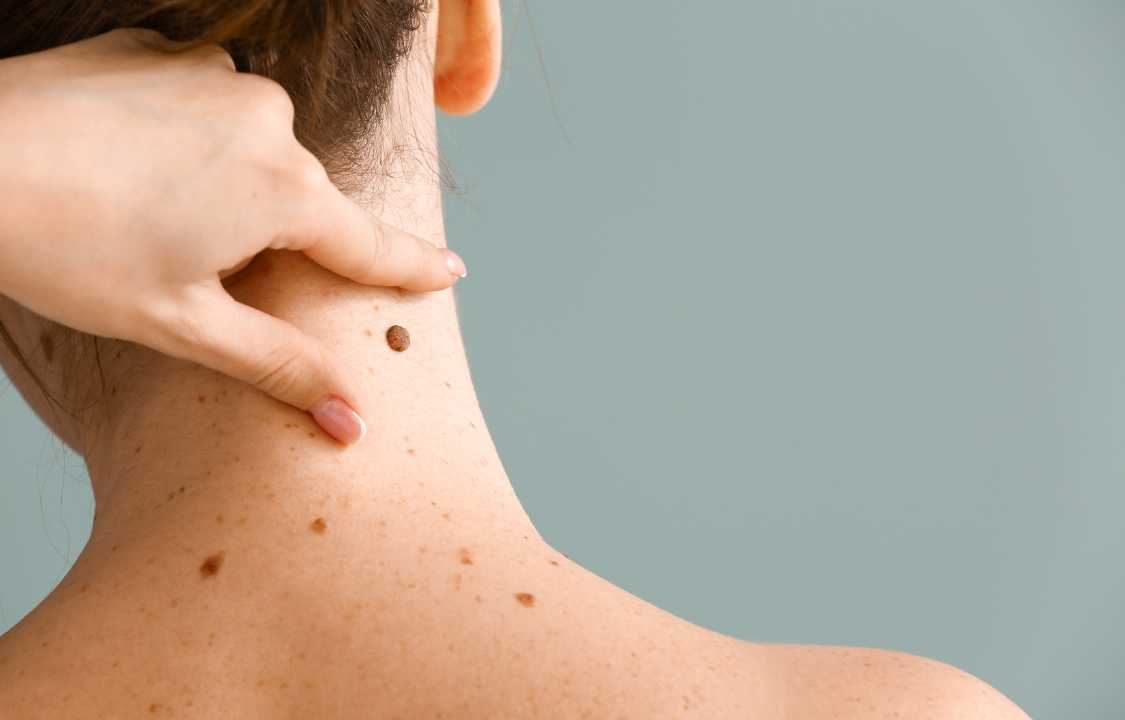Find out the differences between regular moles and skin changes that could be potentially cancerous.
Skin cancer represents the most prevalent and, importantly, preventable form of cancer. This insidious condition arises when the cells in your skin undergo uncontrolled growth, often triggered by exposure to ultraviolet (UV) light.1 Several factors increase an individual’s susceptibility to skin cancer, including a family history of the disease and specific physical characteristics such as light-colored skin, blue or green eyes, and blonde or red hair. Additionally, individuals with skin that burns, freckles, or reddens easily face an elevated risk.2
Fortunately, early detection of skin cancer significantly improves the chances of successful treatment. Vigilance and awareness are key to spotting warning signs promptly, and this can be achieved through regular skin examinations and monitoring of moles.3
The Importance of Skin Examination in Skin Cancer Prevention
Conducting regular skin examinations is a fundamental step in preventing skin cancer. While dermatologists can perform these examinations, individuals can also play an active role in monitoring their skin for any suspicious changes. The “ABCDE” rule—Asymmetry, Border irregularity, Color variation, Diameter larger than 1/4 inch, and Evolution (changes in color, size, or shape)—serves as a valuable tool for evaluating moles and skin abnormalities. Consultation with a healthcare provider or dermatologist is advisable if any moles exhibit the following characteristics:
1. Asymmetry: A mole that lacks symmetry, where one half differs from the other.
2. Irregular or Blurred Borders: Moles with irregular, notched, or indistinct borders.
3. Varying Shades of Color: Moles displaying a range of colors or uneven pigmentation.
4. Diameter Larger than 1/4 Inch: Moles that exceed a quarter-inch (approximately 6mm) in diameter.
5. Changing in Color, Size, or Shape: Moles that exhibit alterations in color, size, or shape over time.
To effectively distinguish between a benign mole and a potential skin cancer, it is essential to conduct self-examinations every few months. This is particularly significant because many skin cancers commence as irregular spots, as noted by Dr. Ariel Ostad, an assistant professor of dermatology at New York University.
Understanding Different Skin Abnormalities and Cancers
1. Normal Mole:
- Description: Moles are benign spots that typically emerge in childhood or later in life and can appear anywhere on the skin.
- Characteristics: Normal moles are generally smaller than a pencil eraser, exhibiting round and symmetrical shapes with smooth borders and consistent coloring. They typically remain stable in size and shape over time.4
2. Actinic Keratosis:
- Description: Actinic keratosis is a common precancerous growth frequently found on sun-exposed areas, such as the face, lips, ears, scalp, shoulders, neck, and the back of hands and forearms.
- Characteristics: These growths manifest as rough, dry, scaly, or crusty patches, often in flesh-toned pink, red, tan, or white hues. Removal is recommended since 5 to 10 percent of them may transform into cancerous growths.5
3. Basal Cell Carcinoma:
- Description: This cancer type, predominantly caused by sun exposure, typically occurs on sun-exposed areas such as the face, ears, neck, lips, and the back of hands.
- Characteristics: Basal cell carcinoma typically presents as a pinkish or reddish patch with raised edges, which may bleed or form scabs. It can also manifest as open sores, flat yellow patches, raised, itchy, red patches, or pink or red translucent, shiny bumps. Early detection is essential, as this type of cancer is treatable when identified early.6,7
4. Squamous Cell Carcinoma:
- Description: Similar to basal cell carcinoma, squamous cell carcinoma often arises on sun-exposed areas, including the face, ears, neck, lips, and the back of hands.
- Characteristics: This cancer is identifiable by thick growths that can peel and bleed and may possess irregularly shaped borders. It may resemble a wart rather than a pimple.7
5. Melanoma:
- Description: Melanoma is a severe form of skin cancer that can spread rapidly but is curable when detected early.
- Characteristics: Melanoma frequently appears as dark, irregularly shaped growths with uneven tan, brown, or black coloring. Advanced melanomas may ooze, bleed, itch, or cause pain. This form of cancer is more common on women’s legs and, in men, it predominantly occurs on the torso.8,9
The Crucial Role of Prevention
Fortunately, skin cancer is highly preventable, with the majority of cases attributed to UV ray exposure. It is important to recognize that UV rays can pose a risk throughout the year, not solely during the summer months or in clear weather conditions.10
To shield yourself from the harmful effects of UV rays, consider adopting the following preventive measures:
1. Covering Skin: Protect your skin by wearing clothing that covers your arms and legs, a hat to shield your head, and sunglasses for eye protection.
2. Sunscreen: Employ sunscreen with a sun protection factor (SPF) of 15 or higher, particularly for areas of the body that cannot be covered by clothing. Reapply sunscreen as needed.
3. Regular Skin Checks: Continuously monitor your skin and moles for any alterations in color, shape, or size. Adhere to the ABCDE guide for assessing moles and consult a healthcare provider or dermatologist if concerns arise. Regular self-examinations can be instrumental in preventing skin cancer.
In conclusion, skin cancer represents a common and largely preventable threat. Vigilance, self-examinations, and adherence to protective measures against UV ray exposure are critical steps in reducing the risk of skin cancer. Early detection through vigilant monitoring can significantly enhance treatment outcomes. By prioritizing skin health and adopting sun safety practices, individuals can take proactive steps in the fight against this formidable disease.

